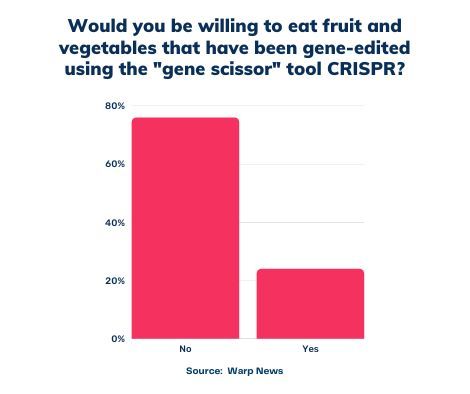
💡 Optimist's Edge: Plant breeding in no time with the gene scissors CRISPR
There is enormous potential for global health in using CRISPR technology to edit DNA in fruits and vegetables. In the future, farmers can be paid more, while consumers can enjoy better and more nutritious products.
Share this story!
📉 What people think
Would you be open to eating fruits and vegetables edited with the CRISPR gene scissors? 74 percent say no, and just 26 percent say yes.

📈 Here are the facts
- The gene scissors Crispr (CRISPR Cas-9) was created in 2012 and brought with it the possibility of editing inside an organism's DNA code for the first time.
- The discovery was awarded the Nobel Prize in Chemistry in 2020, which was awarded to Emmanuelle Charpentier and Jennifer A. Doudna.
- The technology means it is now possible to cut and paste with specific characteristics inside, for example, a crop.
- The result is exactly the same as traditional plant breeding - but many times faster.
- The first Crispr-treated product to be sold commercially was a tomato variety by SanaTechSeed in Japan in 2021. The tomato had been edited to have beneficial health properties, including an increased presence of the amino acid GABA, which is said to lower blood pressure and have a relaxing effect.
What can you do with Crispr?
- Promote adaptability to different types of climate.
- Increase the resistance of crops to various diseases, resulting in less need for pesticides.
- Increase the nutrient content of the crop.
- Produce rapeseed oil without trans fats.
- Coffee without caffeine.
- Products without different allergens, for example, wheat with less gluten.
- From SLU research comes the company SolEdits, which works with Crispr refinement of potatoes. Among other things, potatoes that don't develop acrylamide when making chips and fries.
This is what Mariette Andersson, a researcher at SLU and CEO of SolEdits, says when asked what we are missing with the tough legislation.
"Environmental work suffers from the fact that we cannot move forward faster. These are mutational processes that could just as well take place in nature, we're just helping along the way. When the rest of the world has access to these improved crops, we lose a lot in speed and competitiveness."
- SolEdits collaborates, among other things, with Sweden's Starch producers to produce potatoes that create a better type of starch, which eliminates the need for added chemicals in, for example, creams and sauces. The Swedish starch industry currently uses approximately 5,000 tons of chemicals each year.
- Vegetables with better resilience and stronger colors can help increase shelf life and reduce food waste.
- American company Pairwise is offering its Crispr platform to other food companies and producers to produce healthier leaf lettuce, as well as raspberries, blackberries, and cherries without seeds or cores. They want to make it easier for more people to eat more nutritious food - small steps towards better public health.
Challenges
- Perhaps the biggest challenge for a wide application of Crispr is that the technology gets mixed up with GMOs. But while GMOs involve manipulating a crop from the outside, Crispr is just editing traits that are already in the organism's DNA. However, there are no studies that have so far been able to demonstrate that GMOs would be harmful to humans in any way.
- Legislation is a big threshold. Above all, tough rules have been introduced in the EU against GMOs, and Crispr has had to join the bandwagon. At the same time, development in other countries can continue at a higher speed, which in the long run can lead to a distorted competitive situation. In the USA, the legislation is based on the perspective that regulation is waived if the DNA mutations could have occurred "naturally".
- Resistance from consumers – it is tempting to see the edited crops as unnatural, but this is the same type of plant breeding that otherwise occurs in nature. Man only accelerates the process.
💡 Optimist's Edge
By fortifying crops against disease, increasing resilience to climate change, and making plantations larger and more efficient, big gains can be made at both a business and societal level.
In the long run, the technology can be applied to almost anything. Fruit and vegetables are a good start, but the great potential will likely come - just as during the "green revolution" - with the development of crops such as rice, corn, potatoes, wheat, and oats.
👇 This is how you get the Optimist's Edge
- Keep track of the legislative debate and familiarize yourself with the various arguments. Could we feed significantly more people with more nutritious food if research and development were allowed to progress faster? EU parliamentarian Jessica Polfjärd has argued that Sweden and the EU should lighten the regulatory framework for plant breeding with Crispr. And now things seem to be happening within the EU to get closer to new legislation in the area.
- Support research that works with Crispr to determine what can be done in the future. SLU conducts research within the competence center SLU Grogrund - center for plant breeding of food crops.
- Among the companies exploring the technology today (in addition to Pairwise, SanaTechSeed, and SolEdits) we can mention Ukko, Yield10, Hudson River Biotechnology, and BetterSeeds. Many of these are constantly searching for new collaborations, competencies, and pilot projects surrounding research and development.
- Question the naysayers. What exactly is "natural"? Maybe it's natural to try to improve the world step by step?
By becoming a premium supporter, you help in the creation and sharing of fact-based optimistic news all over the world.


